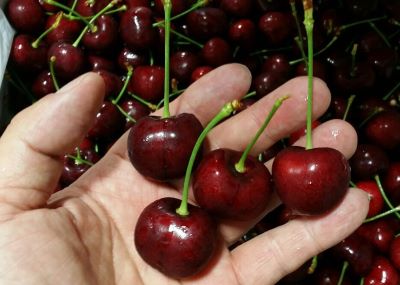Canada wins landmark cherry patent case in the U.S.
By Keith Belinko and Nancy Gardner
Keith Belinko has more than 40 years of experience in intellectual property management and technology commercialization, spanning both the public and private sectors. He is currently a Senior Consultant with Doyletech Corporation.
Nancy Gardner served as Director of the Office of Intellectual Property and Commercialization at Agriculture and Agri-Food Canada (AAFC) for nine years. During her tenure, she and her colleagues initiated and led the Staccato™ cherry patent litigation. She recently retired from AAFC.


Canadian entities, especially SMEs, seeking to enforce patent rights in the United States face a unique set of challenges that go well beyond the normal difficulties of litigation.
One of the first hurdles is establishing clear legal standing. U.S. courts require that the plaintiff hold full ownership or exclusive rights to the patent at the time of filing. Without airtight assignment and documentation, a case can be dismissed before it even reaches an argument on its merits.
Even when standing is established, the costs and complexity of U.S. litigation can be daunting. The discovery process is far more expansive than in Canada, requiring the production of extensive documents, depositions and expert testimony.
Canadian plaintiffs must also meet rigorous evidentiary standards, especially when cases involve specialized technical or scientific issues, such as genetic testing in plant patent disputes.
In such cases, it is critical that the lead professional of the file possesses both a deep understanding of the underlying science and expertise in intellectual property (IP) law. Many SMEs, however, lack access to IP practitioners with the necessary combination of legal and technical skills to effectively lead such litigation.
Geography and procedure add another layer of difficulty. Canadian organizations must navigate a foreign legal system with different rules, judges, and sometimes juries unfamiliar with their industry.
Even if a case is won, enforcement of remedies, particularly injunctions or damages, can be slow or complicated, and defendants may exploit procedural loopholes or file appeals to delay resolution.
Finally, high-profile agricultural or technology cases can attract political attention, adding trade or diplomatic considerations to an already complex legal landscape.
Taken together, these factors illustrate why filing and successfully litigating patent infringement cases in the U.S. requires careful planning, detailed documentation, and substantial financial and organizational resources.
Properties of the Staccato™ Cherry
 The Staccato™ sweet cherry (photo at left) is one of the most successful late-season cherry varieties to emerge from Agriculture and Agri-Food Canada’s (AAFC) breeding program at the Summerland Research and Development Centre in British Columbia.
The Staccato™ sweet cherry (photo at left) is one of the most successful late-season cherry varieties to emerge from Agriculture and Agri-Food Canada’s (AAFC) breeding program at the Summerland Research and Development Centre in British Columbia.
First identified under the breeding code 13S-20-09 in the early 1980s and released commercially in the mid-2000s, Staccato™ was the result of decades of careful selection work by breeders.
Genetic testing has shown that Staccato™ is a self-pollinated seedling of the popular Sweetheart cherry.
The properties of Staccato™ are quite unique. It ripens exceptionally late, roughly 27 to 29 days after the classic Bing cherry and about a week later than its Sweetheart parent.
This extends the cherry harvest season into a high-value market window when most other cherries are long gone.
The fruit is large, firm, dark red, and heart-shaped, with long stems and a natural resistance to rain-induced cracking. The variety is self-fertile, making orchard planning easier.
The commercial rights to Staccato™ were granted by AAFC to Summerland Varieties Corp. (SVC), a B.C.-based Canadian company, which subsequently sublicensed those rights to Stemilt Growers in the United States.
Infringement of the Staccato™ Cherry patent in the U.S.
The variety’s commercial success and its controlled licensing made it a valuable piece of Canadian intellectual property, and the center of a prolonged legal battle in the U.S.
In May 2020, AAFC, representing the Government of Canada, filed suit in the U.S. District Court for the Eastern District of Washington against Van Well Nursery, Monson Fruit, and orchardists Gordon and Sally Goodwin.
The lawsuit alleged that the defendants were propagating and selling a cherry called “Glory” that was Staccato™ under another name, in violation of AAFC’s U.S. Plant Patent No. 20,551. The defendants denied all claims, presented their antitrust counterclaims against AAFC and SVC, and filed a motion to invalidate the Staccato patent.
The case unfolded over several years. In early 2021, the court confirmed that AAFC could proceed without adding SVC as a party, recognizing that AAFC held all substantial rights in the patent. AAFC is also the owner of the Staccato trademark.
In December 2022, the court invalidated AAFC’s patent under the “on-sale bar” doctrine based on false evidence of sales before the patent’s filing date.
The on-sale bar, codified in 35 U.S.C. 102(a)(1), prevents patenting an invention that was on sale more than one year before the filing date of the patent application. During the same period, the court denied the defendants' motion for the antitrust counterclaim.
In August 2024, after hearing extensive genetic and phenotypic evidence, the court ruled that “Glory” Cherry was indeed genetically identical to Staccato™, a major factual win for AAFC.
On March 12, 2025, the court vacated its decision and reinstated the patent after finding that the alleged early-sale evidence was flawed. The supposedly incriminating sales were actually of a different variety, Sonata, and the defendants’ spreadsheet had omitted key rows that showed this.
The reinstatement reopened AAFC’s infringement claims and significantly strengthened its position. In the months that followed, the court rejected attempts by the defendants to overturn the reinstatement.
In April 2025, AAFC’s U.S. plant patent expired, but the Staccato trademark is still active.
Significance of the Staccato™ Cherry litigation case
Staccato™ is both a horticultural and legal landmark. It is valued by growers for its ability to capture late-season premiums and by plant breeders as a symbol of Canadian innovation.
In the legal sphere, it stands as a case study in how genetic fingerprinting can settle varietal identity disputes and how careful documentation can make or break a patent case.
With the patent now restored and the identity ruling in place, the story continues to shape the conversation around intellectual property protection in agriculture.
Staccato™ is a prime example of Canadian agricultural innovation – combining breeding excellence with commercial impact. The associated litigation underscores both the economic stakes in late-season specialty fruit and the legal complexities of plant variety protection.
As of August 2025, the courts have confirmed that “Glory” is the same cultivar as Staccato. The case continues to influence both horticultural practice and IP enforcement strategies across the industry.
This episode underscored how vital it is for breeders to maintain airtight records of breeding history, licensing, and sales.
Five years on, the case demonstrated the value of securing foreign IP rights early, structuring them so enforcement can be direct, and retaining top-tier local legal counsel with agricultural IP experience.
Beyond the courtroom, the successful reinstatement of the Staccato™ patent has sent a powerful deterrence signal to would-be infringers in the U.S. market – that Canada will pursue its rights aggressively and persistently.
In the broader picture, the Staccato™ litigation shows that Canada can successfully defend its agricultural innovations abroad, provided it invests in early patent filings, rigorous technical documentation, and sustained enforcement strategies.
It is essential to establish legally binding agreements when sharing plant materials, clearly defining the rights, obligations, and limitations of use.
Equally important is ongoing market monitoring to identify any unauthorized use or commercialization of the material without proper licensing or permission. For breeders, whether public or private, the case offers a clear playbook - protect early, record everything, prepare for a long fight, and make your enforcement visible.
This combination not only preserves the value of Canadian plant breeding efforts but also reinforces Canada’s credibility as a determined and capable defender of its agricultural intellectual property.
R$
| Organizations: | |
| People: | |
| Topics: |
Events For Leaders in
Science, Tech, Innovation, and Policy
Discuss and learn from those in the know at our virtual and in-person events.
See Upcoming Events
You have 0 free articles remaining.
Don't miss out - start your free trial today.
Start your FREE trial Already a member? Log in
By using this website, you agree to our use of cookies. We use cookies to provide you with a great experience and to help our website run effectively in accordance with our Privacy Policy and Terms of Service.




